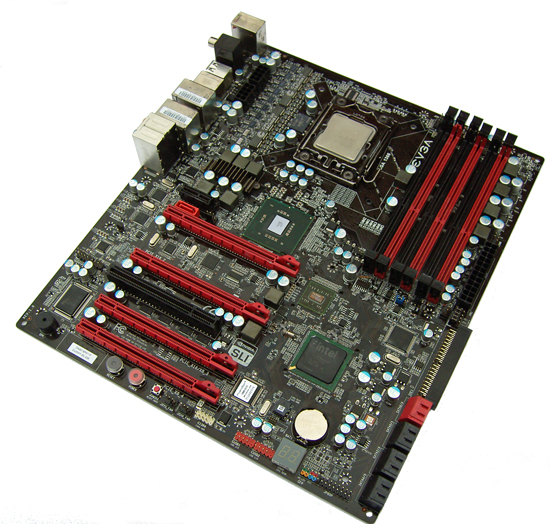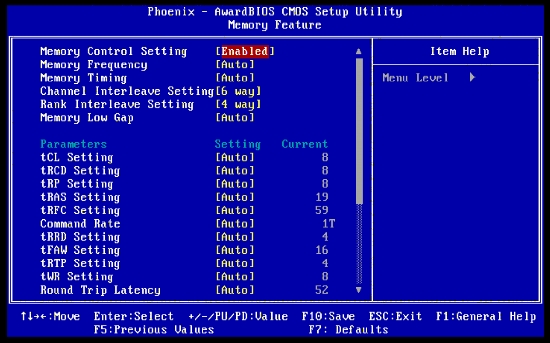EVGA X58 Classified - First Look
by Rajinder Gill on February 27, 2009 5:00 AM EST- Posted in
- Motherboards
BIOS Breakdown

Extreme Cooling
This function is only to be used when the CPU is cooled to subzero temperatures. Three settings are available depending upon the temperature range the CPU will be operating at for benchmarking. An alternative to this BIOS function is to move the onboard X-Cool jumper to pins 2-3, although the effects can be a little different to those offered in the BIOS. Our particular i7-920 CPU prefers the X-Cool jumper left at position 1-2, needing no change in the BIOS to reach the limits of thermal shutdown conditions. On the other hand, our i7-965XE processor prefers the X-Cool jumper at position 2-3. For us, we found we were able to boot and run our i7 processors another 10~15 degrees lower on the Classified than the cold boot limits imposed by other boards with these same CPUs.
PCI Express Frequency
This is useful when pushing the board beyond 222 BCLK. A setting of 102MHz will allow the BCLK frequency to be ramped past 222MHz using the E-LEET tuning program in the OS. For speeds past 230 BCLK, we used a setting of 114MHz. You can then boot into the OS at 220 BCLK and apply BCLK changes to take you directly to the desired CPU frequency. The use of high PCI-E bus frequencies does affect 3D stability however; too high and 3D benchmarks will lock mid-run. Settings over 117MHz or so give rise to SATA problems at times, so it's a case of edging up slowly and keeping your fingers crossed if you're going for an all out attempt at a maximum BCLK setting.
Profiles
Eight CMOS profile slots are available for saving your settings. Unfortunately, there is no way to name the saved profile for easy reference, which would have been a nice touch. Still, having these banks on hand makes it easy to re-apply previous settings when experimenting.

Memory Control Setting
Enabled: Allows manual control of Memory Frequency, Channel Interleave, and Rank Interleave.
Memory Frequency: This is the memory multiplier ratio to BCLK. It's self-explanatory based on the ratios and speeds listed. For those just starting on the i7 platform, a memory ratio of 10 (1333) and a base BCLK speed of 133 will result in a DDR3-1333 (10x133) memory speed as one example. As you clock up bus speeds, you will need to lower the memory ratio to keep your memory operating within specifications.
Memory Timing: EVGA has managed to find a number of memory controller presets based on the applied memory frequency. Our testing to date has shown no real performance gains between any of the presets other than stability, so we're veering towards calling this a signal timing offset rather than a latency adjustment. At stock processor speeds (133 BCLK), one can use the appropriate memory divider and MCH frequency setting to obtain the stock memory frequency. If you intend to experiment with individual MCH frequency settings then do note that if using the 1867 and 2133MHz presets that memory frequency must be close to the speed of the MCH preset. As an example:
BCLK 133MHz
Memory Multiplier 2:14
Uncore Multiplier 28
MCH "strap" = 1867
MemFreq =1867MHz
…POSTs
BCLK 133MHz
Memory Multiplier 2:10
Uncore Multiplier 20
MCH "strap" = 1867
MemFreq =1330MHz
…Fails to POST.
But:
BCLK 186MHz
Memory Multiplier 2:10
Uncore Multiplier 20
MCH "strap" = 1867
MemFreq =1860
…also will POST.
If memory frequency is below MCH "strap" frequency using the 1867 preset, then the minimum consistent boot up memory frequency is in the region of 1770MHz. Memory speeds over the MCH preset frequency are not as susceptible to non-post situations. The 1600MHz preset seems to be the most scalable and stable preset in our testing to date. Values in between the presets are catered for using the "by DRAM ratio" setting, which scales signal timing offsets in conjunction with memory frequency and BCLK.
Channel Interleave: Higher values divide memory blocks and spread contiguous portions of data across interleaved channels, thereby increasing potential read bandwidth as requests for data can be made to all interleaved channels in an overlapped manner. For benchmarking purposes when using three memory modules, a 4-way interleave may surpass the scoring performance of setting 6-way interleave depending on the benchmark and operating system used (32-bit vs. 64-bit). We did find however that a 6-way interleave was capable of a higher overall BCLK for Super PI 32M than using a 4-way interleave setting (unless of course you run single- or dual-channel and appropriate channel interleaving thus decreasing load upon the memory controller).
Rank Interleave: Interleaves physical ranks of memory so that a rank can be accessed while another is being refreshed. Performance gains again depend on the benchmark in question. For 24/7 systems using triple-channel memory configurations there is no advantage to setting this value below 4 while Channel Interleave should be left at 6 for best overall system performance.
The rest of the memory parameters pretty much default to optimum levels; moving away from these values can in some instances make matters worse in terms of system stability rather than performance. The current BIOS defaults are just about optimal for most overclocking. The highest performance advantage comes from changing the primary memory timings. There's little to no gain in fiddling with any of the secondary timing ranges, other than moving tRFC out to a value of 88 or more if running 12GB (6x2GB) of memory.















22 Comments
View All Comments
rogguy - Thursday, March 12, 2009 - link
this board is mediocre compared to asus ROGEverlong19 - Thursday, March 12, 2009 - link
How can you have a triple GPU setup using dual slot cards and have room for a physics card/sound card?Only way it might be possible is putting the 3rd card in the 4th PCI-E slot, but that would overlap the USB headers etc. The PCI slot gets covered by the 2nd GPU, so any PCI sound cards can't go in there, either.
MadMan007 - Saturday, February 28, 2009 - link
The important thing I take away from this preview has nothing to do with the board itself but rather eVGA's expanding custom software and software/hardware efforts. It's really neat to see a company like eVGA make a push in this direction going well beyond other mobo companies with their basic monitoring software and other graphics rebadgers.MasonStorm - Saturday, February 28, 2009 - link
You could certainly do it, as stated, by plugging one of the dual-slot cards into that last slot, and having it hang over the edge of the board - requiring an extra big case. But another way is to use liquid-cooled versions of the cards, cutting them all down to single-slot size. In any event, it doesn't matter where you place them, since you can use three of the soft, bendy SLI bridge connectors to make your own triple-SLI connection. You don't have to use anybody's firm, fixed triple-SLI connector. Just Google around to see how to use the three individual, soft, bendy connectors.Casper42 - Friday, February 27, 2009 - link
Question on this comment:The slot configuration allows running three dual slot GPUs and a single slot PhysX card or other PCI-E peripheral
In looking at the pictures, this board only has 7 slots total with the x1 being at the top.
If you used 3 Dual Slot GPUs, that would be 3 x 2 = 6 + the x1 = 7
So where exactly are you putting a PhysX card?
The only possibility I see is if you use an 8 or 10 slot Case and stick the 3rd Dual Slot GPU in the very bottom slot such that it hangs off the bottom of the mobo. But in this case, the normal 6 connector Triple SLI Bridge wont reach the 3rd card.
Am I missing something here?
PS: Dont get me wrong, I like the design of the board.
Rajinder Gill - Friday, February 27, 2009 - link
You are right the 3rd SLI card would go in the last PCIe slot, with a dual card overhanging. An SLI bridge supporting this will ship with the retail board.Board dimensions are 310mmX265mm btw. Big case territory.
regards
Raja
cesthree - Friday, February 27, 2009 - link
Remember the awesome 7X0i series of motherboards? Especially the last one with the NF200 on it? It's called a 790i "Ultra" chipset.There are only a few people who ever had problems with the 7X0i series motherboards when using multiple GPU's. Not one person ever complained about things like "freezing" or "hard locking" or "data corruption." Especially not at stock speeds.
Just like there is absolutely no sarcasm in my last paragraph.
What fool would by the "Classified" EVGA motherboard? It's got negligible performance increases. Why go through that much trouble for all of the 5 people on earth who would purchase it and use it with 3-4 GPU's + 30" or bigger monitor.
Mark my words. The NF200 addition to the X58 that EVGA already had going GREAT for them, will bring them problems on the level with the last batch of shoddy, Nvidia tainted motherboards.
I am going to put this in all my sigs from now on:
"Nvidia, for the love of god, please stop crippling motherboards and just stick to GPU's."
Von Matrices - Friday, February 27, 2009 - link
From what I can tell from sources online, the NF200 bridges 16 PCIe 1.1 lanes to 32 PCIe 2.0 lanes. What is there to gain by using the NF200 over just using four PCIe x8 2.0 lanes of bandwidth from the IOH? With the NF200, you get ~4GB/s bandwidth to the IOH per graphics slot compared to ~8GB/s with a native solution, and the bridge adds additional latency, which further reduces performance, and additional cost. Why would EVGA use it then? Are there any advantages to it?Zak - Friday, February 27, 2009 - link
Question. 920 can be easily o/clocked on most boards to 4GHz and peak under 80C under full load using a good air cooler and be perfectly stable. But how long will that CPU and mobo last at these temps and bumped up voltages if used daily? The temps can be addressed by water cooling but how damaging is running CPU at 1.4V, QPI at 1.5V/7.2GHz for long time?Z.
Agoniesfury - Saturday, January 23, 2010 - link
Well I can testify to this comment, and say that I'm an enthusiast and like to buy top rated tech and push their limits, over 8 months ago I purchased a R2E to be used with my 1yr old 920 only bad part was the 920 was a C0 but nonetheless I was able to get to 4.1ghz for benching and everyday stablity "non prime stable", which did fine until 2weeks ago when the board just blinked at me and nothing more, well thank god for rma! So I did decide to upgrade to a classified 760, well in my case I lost some of the bells and whistles that the asus had but was better greeted with the hardware imporvements and design of the evga has. I'm now at 4ghz and climbing 8hrs+ prime stable where as the r2e only was prime stable up to 3.6. So I think both boards are great but the classy is a hair better and hope it lasts!P.S. I've been overclocing for about 10yrs and I never had a chip fry on me it's always the mobo from decay I asume, and the 920 it's self has been through 2 powersupplies and three mobo's.